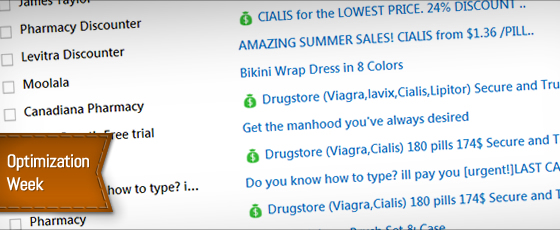Email Marketing (All)
Six Keys to Keeping Your Resort’s Emails Out of the Spam Folder


BLANCHARD
Filters are everywhere. They’re on Google, they’re on Facebook, they’re in your email inbox. So this week we’re talking about resort optimization to work with these filters to get your content the most visibility possible.
We love our spam filters when they keep manly offers from our inbox, but curse them in futility when our carefully crafted emails start showing up on their radar.
Or, are your four-letter refrains futile?
The Source
I’ve shared a couple of these insights before, but wanted to revisit, add a few more details, and lump them in with the rest of the optimization principles this week.
The source of such boundless wisdom is SendGrid. These guys deliver a butt-load (during the last month, my daughter has given this middle school term new life in my vocabulary) of emails, working directly with the big guys along the way. Their insights are clear, make a ton of sense, and are very actionable.
Let’s get right to the point.
#1) Maintain Your List
Email providers use performance of campaigns as an indicator of value. Like Facebook rewarding engaging posts with more visibility on future content, email takes a similar route.
The key here is segmentation, in two ways. First, knowing your subscribers and segmenting them into lists that match the content of your campaigns keep performance high. Second, segmenting out people that haven’t opened or clicked an email in the last while gives you a group that can be easily excluded from many of your campaigns: again, keeping performance high and your resort on the good side of the email providers.
#2) Avoid Spikes
The second factor spam dectecting algorithms look at is volume over time. You may have heard the practice of “warming up” an new IP address. That’s because massive spikes in email volume from a specific sender are often linked to spam.
If you decide to ramp up email efforts, make sure you do just that: ramp up rather than send 10,000 a week in January and 250,000 a week in February.
#3) Watch Bounce Rate
Another indicator these guys watch is bounce rate. If you get a “soft bounce” (aka, the address’s domain exists but for some reason isn’t able to be delivered to that address), SendGrid recommends applying a baseball-esque three strike rule. After three bounces, don’t try sending again.
On the other hand, if you get a “hard bounce” (aka, the domain it was trying to send to does not exist – perhaps because of a typo), they recommend you never send to that email address again.
#4) Text to Image Ratio
Let’s say you’re sending spam and want your red-flag words to fly under the radar of the filters. Just make them images, right? Well, that’s exactly why your text to image ratio is critical: spam algorithms watch that number carefully with each campaign.
The rule of thumb they suggest is that for every image in your email, there should be at least a couple lines of text. Some people have suggested adding thorough ALT text for each image can help.
#5) DKIM
DomainKeys Identified Mail (DKIM) is a way you can associate your domain name to the emails you send. Think of it like a digital signature that tells the email provider, “yes, we are the ones that sent this email.”
Spammers like to forge the address in the headers of their emails so the recipient thinks it is coming from a trusted source. Because their sending domain doesn’t match the domain in the email, they can’t use DKIM. When you do, you set yourself apart from the spammers.
#6) Never Buy Lists, Ever
The final key to deliverability is to gather email addresses directly. Buying lists is asking for trouble. First, because there’s no relationship between the recipient and you the recipient see it as spam and, as performance drops, so do the email providers.
Second, you have no guarantees that the list doesn’t contain spam traps. The easy, smart, obvious solution is to never, ever, ever, ever, ever, ever buy email lists. Period.
On Your Marks
This is a starting point. For a long time, I never even considered optimizing my email lists. Today, it’s essential.
You can’t just blast out anything and everything to everyone. It takes an intelligent approach, segmentation, and a few extra steps to keep as many of your emails out of the spam folder as possible.
I’m trying my best to learn this increasingly critical skill. I’d invite you to do the same.
About Gregg & SlopeFillers
I've had more first-time visitors lately, so adding a quick "about" section. I started SlopeFillers in 2010
with the simple goal of sharing great resort marketing strategies. Today I run marketing for resort ecommerce and CRM provider
Inntopia,
my home mountain is the lovely Nordic Valley,
and my favorite marketing campaign remains the Ski Utah TV show that sold me on skiing as a kid in the 90s.
Get the weekly digest.
New stories, ideas, and jobs delivered to your inbox every Friday morning.
